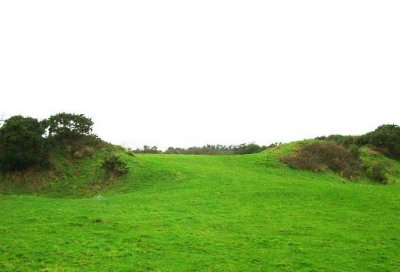
Ancient Hillfort
Two miles North of Fowey
Castle associated with King Arthur
Castle Dore is a small circular fort dating from 200 BC. "Castle Dore" could have come from the Cornish for "earth castle". It consists of two ditches surrounding a circular area 259 feet in diameter. It is surrounded by a double bank of earth, turf and stone, fronted by v-shaped ditches and with a wide entrance on the east (sheltered from the prevailing wind). Hut circles have been recorded within the interior of the fort. The defences enclose an area of only 1.25 acres.
Additional wooden gateways were installed perhaps around 50 BC. Whatever the reason, the walls were built up, probably topped off with wooden fencing, and a covered gateway erected over the entrance.
Occupation at the hillfort seems to have ended around 200 AD but it was re-used in the 5th century, when two large, rectangular timber-built hunting lodges were erected on the site.
A small village existed outside the eastern gate of the hillfort in its early days. And also aerial photos show a circular site of some sort a short distance to the south-west of the hillfort which could have been an earlier Bronze Age henge. This could have been where the Tristan Stone originated.
Castle Dore was probably abandoned shortly after the Roman invasion of Britain. There is no evidence of there having been any battle here for control of the fortress.
The Castle Dore hill-fort is associated with the figures in a King Arthur legend of King Mark and Tristan. (The so-called Tristan's Stone is located nearby). King Mark was the son of King Felix of Cornwall who died after a raid on his castle at Tintagel by the King of Ireland. There is some archaeological evidence of 5th or 6th century settlement. Traces of a wooden hall could possibly have been associated with King Mark. Though others say that this fort was only occupied in the Iron Age/Romano British era and that King Marks Hall was a few miles north of Dore (possibly at Lantyan, a nearby manor mentioned in the Domesday Book, and which could be the Lancien of the Tristan and Iseult story).
Castle Dore was not used again until the English Civil War of the mid 1600's. In August 1644 the Parliamentarian Army commanded by the Earl of Essex, used the site as a camp. King Charles I and his army surrounded the castle in August 1644, but Essex and Lord Robartes of Lanhydrock had slipped away to Plymouth in a fishing boat. The remaining Parliamentarian army, under Major General Philip Skipton, surrendered and the 6000 men were disarmed. It appears that only around 1000 of these actually survived the fury of the local populace.
The hill-fort has wonderful views over the surrounding countryside The valley would have been flooded when in was occupied. However today the fort has become badly damaged by the cattle that wander freely over it. Basically with little governmental protection, the fort is reverting back to nature, with a little help from the cows.
Excavated in the 1930's, it is one of the most intensively investigated Iron Age hillforts in Cornwall.
Two miles North of Fowey at the Golant turning off the B3269 road.
Opening TimesAll Year Admission Free |
Ancient Sites in Cornwall Cornish Castles Fowey Golant Tywardreath Cornwall's History